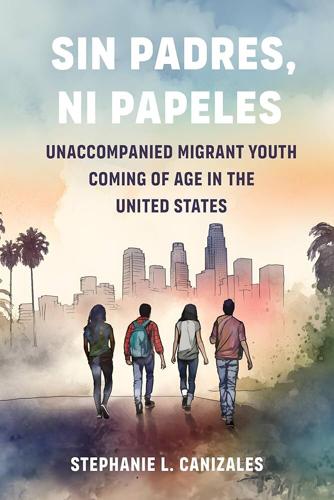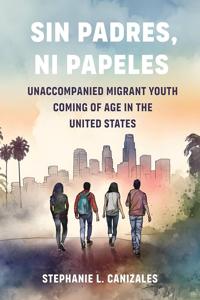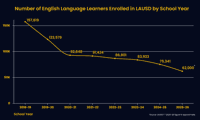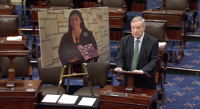
In the acknowledgements section of the book “Sin Padres, Ni Papeles,” you'll find the usual thank-yous to everyone who helped with the book, including her parents.
But for a book about the migration and coming-of-age of unaccompanied children from Central America and Mexico in the U.S., this thank you carries significant weight and resoluteness given the author’s parents were immigrant teens from El Salvador.
Stephanie Canizales draws on over a decade of research to tell the stories of unaccompanied migrant youth in Los Angeles, California, in her new book "Sin Padres, Ni Papeles: Unaccompanied Migrant Youth Coming of Age in the United States."
While the book is filled with stories from these unaccompanied migrant youth, Canizales introduces key terms and concepts that clarify the multifaceted challenges they encounter, offering readers a more multidimensional understanding of their struggles.
With a background in sociology, Canizales employs a nuanced analytical framework built on trust and time to understand the social, emotional and economic factors shaping these different experiences.
This interview has been edited for length and clarity.
I do want to start with the end of the book first, specifically when you detail your field work. You bring up moments during your field work of feeling unsafe and sometimes being harassed. And I just wondered how those experiences shaped how you approached your later field work, and what would actually become this book.

So I think one of the really important features of the book was not just the questions I asked or the spaces I was able to access … I was new to grad school, in my early 20s when I started the project. So I'm interviewing people that are also 19 and up and I was sort of, as we all do, perceived in these different spaces. So I started with the support group that I detailed in the book, Voces de Esperanza, that was a youth space. So when I started to move out I wanted to scale the project up and try to recruit young people not just in these community spaces that I write a lot about. I was trying to recruit people in public settings and I think that's when my age, my gender, and my Americanness started to stick out more, when I wasn't in a youth-protected space. So I talk in the appendix about how when I went to the Home Depot, I was harassed by older men. I went to a day labor site in Northeast L.A. and again, people were like, what is she doing here? So what that produced is a book that tells largely a positive incorporation experience, [an experience] that is also really intensive, traumatizing and violent. But young people I detail how they positively coped with that and how they did that collectively.
The reason I start with that question is I don't believe enough people speak, let alone know, about people who can be at risk of harassment during anything that has to do with field work.
You also asked how it shaped how I do my research. I think it changed the way I dress, the way I talk to people and the way I approached people, who I imagined as potential participants in the stuff. It also has shaped the way I go about the project I'm doing now. I think as social media makes us more aware of how violence just kind of comes at you fast and out of nowhere, and especially against women, I'm less inclined to just put myself in a field site the way that I did 10 years ago for this project.
In the beginning you mention that there is a shift from an English title to a Spanish one, which I believe suggests a deeper cultural resonance. How did that choice enhance the book's impact and message?
In transitioning to this book, which I hope will be widely read by the general public, I was able to kind of step back from the defensiveness of my sociology self and speak more narratively to the experience that I was observing on the ground. If I'm going to reimagine the incorporation process and I'm going to critique the gap between the way sociologists think about incorporation and the way people experience it on the ground, language became a really important way of grounding the incorporation process. When I was thinking about the title I wrote about how I was very proud to tell one of my dissertation committee members that I got it. The title of the dissertation was “Finding Home” and that wasn't really what I was describing.
I told my committee, “I got this new title,” and I was asked, “Well, how would your participants describe it?” So I actually had the really great privilege earlier this year, meeting with some of the same young people and then they asked me, “What's the deal with the book?” I told them it has a title, and said “Sin Padres, Ni Papeles.” And they just looked at me and said, yeah, that's it. I was like, hell yeah. I got it.
You were doing your fieldwork for a very long time and your research spends nearly three presidential terms, each with distinct immigration policies. How did those evolving political landscapes shape your conclusions?
So I think on a macro level, the presidential terms didn't matter. I'm talking about a population of young people that wasn't apprehended at the border, but no one knows that they're here, right? They're doing work that we have convinced ourselves does not happen in the U.S., factory work, exploitative domestic work, all of this stuff that we're hearing now about child labor. So the administration really doesn’t matter at a very high level, because of our posture towards undocumented people, broadly speaking.
What on the micro level mattered, is the lived experiences of undocumented young people on the ground. We had a category of young people that we considered deserving of recognition, inclusion, and at least temporary legal protection. So it was meaningful to my participants who didn't have the language of deserving this in 2012 or didn't have the language of unaccompanied in 2014 to now have that language to talk about. Over time, young people start to learn about these segments of the youth population, the immigrant youth population, and then undocumented immigrant youth. And begin to compare themselves and their lives, their lived realities, with what they imagine these other people do or don't have access to. So, yeah, in that sense, the political landscape both didn't matter, and then also very much did.
I want to shift to talk about some of those terms you use in the book, like orientation, (dis)orientation and specifically, incorporation. You propose that incorporation is a continuous process rather than a fixed endpoint. How does that perspective challenge conventional views of immigrant assimilation?

So the idea of incorporation, it's ancient. People use it interchangeably with the term integration. So this idea that there is a superior, dominant culture, and that immigrants must shed whatever inferior culture they bring with them to become this superior American is the general premise of assimilation. So assimilating like that is a colonial framework. It's what people in power attempted to do to subordinate groups. So we have stayed away from assimilation and turned toward the idea of integration, or I use incorporation, which also takes into account social, political, and economic forces.
Incorporation as a framework does not assume the way assimilation does, that everyone has an equal chance at the end product. But that different groups have different starting points and Latinos have always been considered disadvantaged since the inception of an incorporation framework, because of the racialization of Latinos, because of the disproportionate illegality of Latinos and so forth.
You talk about how you were on the sidelines for your research in the beginning, observing meetings from the side, participating only when necessary. And then you eventually find yourself leading meetings with youth. Did those interactions change your understanding of their struggles and their resilience?
So when I initially started the research people wouldn't say hi to me, they wouldn’t make eye contact. I thought maybe I shouldn't come. And the coordinators would tell me, they're like that with everyone. So a part of it was, I'm not indigenous, right? I'm not an unaccompanied worker. I'm not a garment worker. I was basically in their space. What that taught me was the sort of protective mechanisms that indigenous young people have to put in place. And this is again a legacy of colonial racism and anti indigenous racism. So I was an outsider that could have potentially been harmful in that space, there was so much reason to not trust me, and I'm fully aware of that. I think the evolution of that relationship taught me a lot about orientation and adaptation, and how long that takes for indigenous young people. It was through the consistency of showing up every week and the reciprocity.
When I started writing these questions for you, I always went back to the book and usually found the answer in the book. But I have a quote from the book that really struck me. "Under such conditions the United States, and Los Angeles more specifically, became what Adan called "un lugar de perdición" (a place of perdition).” In your eyes, what factors contribute to that perception, and how does that reflect the broader experiences in the US?
When young people leave their origin countries, I talk about how it is important both that they are displaced migrants, not acknowledged as refugees in the U.S., but very much fitting the bill in that sense. They're young people who are as we all do when we're adolescents. And teenagers start to think, what am I going to do when I grow up? Who am I going to be? What is my life going to look like? And I think really drawing out that again, the multi-dimensionality of an immigrant's life, in this case, that they are both the hopeful migrant, that thinks once I get there, things will be different, they're also the teenager who thinks my future will be better.
So when young people are navigating both realities of being immigrants and being adolescents transitioning into adulthood, they don't find the material and emotional resources to achieve that original, imagined future. There's a deep despair, hopelessness, angst that sort of characterizes their lives, and the U.S. becomes “un lugar de perdición” because you're trapped.
I thought it was great that you reinforced these ideas of orientation, perdition, adaptation and disorientation. Especially in the context of strong family ties that Latin American immigrants have and those close knit relationships that intensify disorientation and orientation in new environments. I thought there was also a part of that that almost spoke to any immigrant, not just Latin American immigrants. Did you find that at all?
As much as I want to write a book about unaccompanied undocumented Central American and Mexican youth in L.A., I also really want to write a book about the immigrant experience. I think the concept of disorientation to orientation, adaptation and so forth, could apply to anyone. I think a lot about the sort of similarities between unaccompanied youth in my research, and foster youth that are aging out of care. There's resonance there. I think about incarcerated individuals and the resonance in these concepts. I would hope to go beyond unaccompanied youth to other immigrant populations.
I saw that in so many of the people you spoke to, I saw so much of who my dad was and who my mother was at one point in their lives. I think it [the book] connects that bridge for someone like me or you, who was born here in the United States, and might not have a full picture of what it was like to go through that process.
Yeah, exactly. My parents were both unaccompanied teens from El Salvador, when they got to L.A. and they don't really talk about it even now, knowing what I do and what I write. They're not out here telling me stories because a lot of it is so traumatizing. So I always say, I learned a lot about my family by writing this, doing this research, and writing this book in a way where now I can kind of put some pieces together. And I'm like, oh, that's why my mom does that, or that's why we don't talk to that tío anymore. You start to kind of put it together, but it's not because anyone told you directly.
“Sin Padres, Ni Papeles: Unaccompanied Migrant Youth Coming of Age in the United States." releases August 6. You can pre-order a copy here.















(0) comments
Welcome to the discussion.
Log In
Keep it Clean. Please avoid obscene, vulgar, lewd, racist or sexually-oriented language.
PLEASE TURN OFF YOUR CAPS LOCK.
Don't Threaten. Threats of harming another person will not be tolerated.
Be Truthful. Don't knowingly lie about anyone or anything.
Be Nice. No racism, sexism or any sort of -ism that is degrading to another person.
Be Proactive. Use the 'Report' link on each comment to let us know of abusive posts.
Share with Us. We'd love to hear eyewitness accounts, the history behind an article.